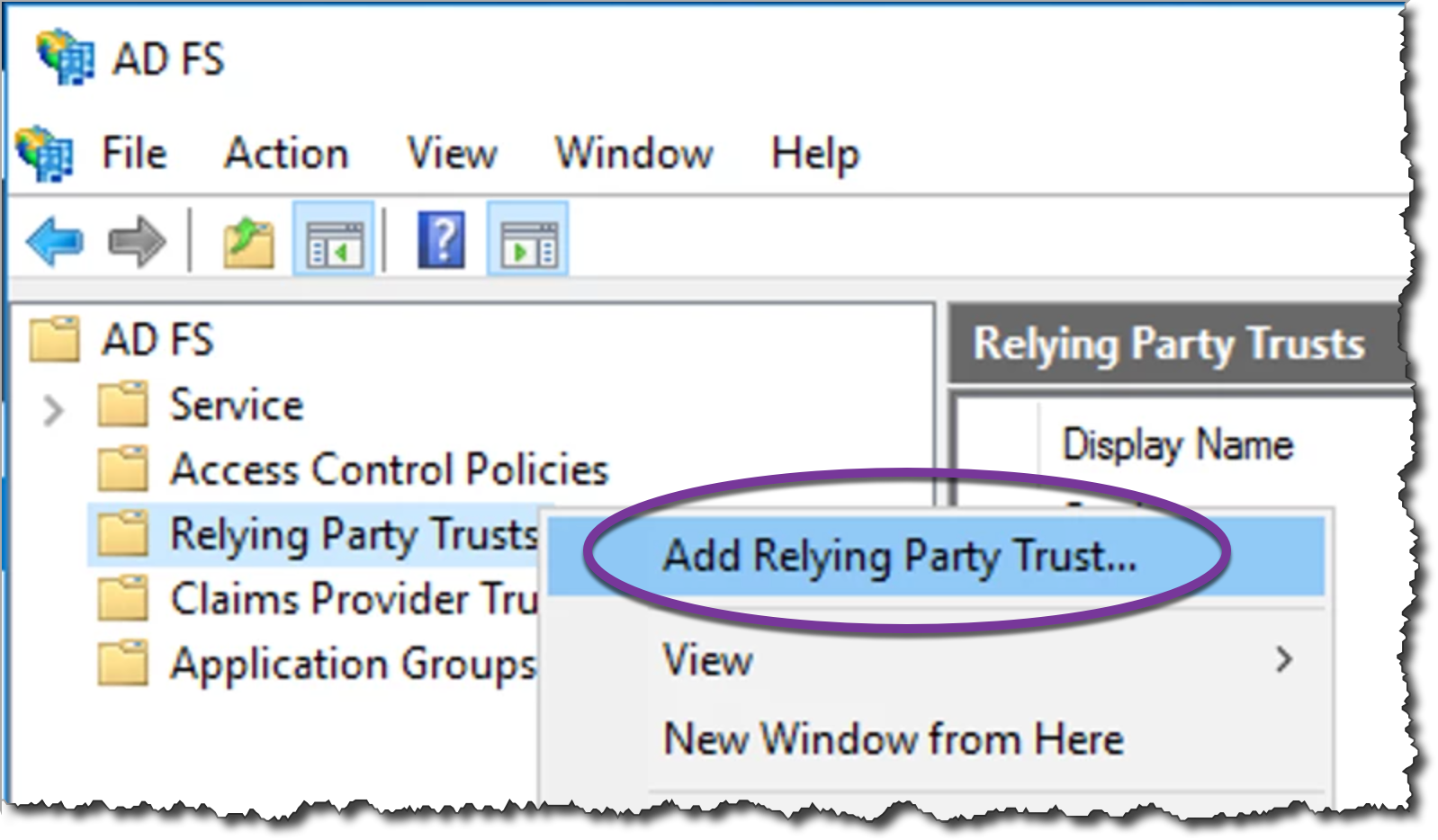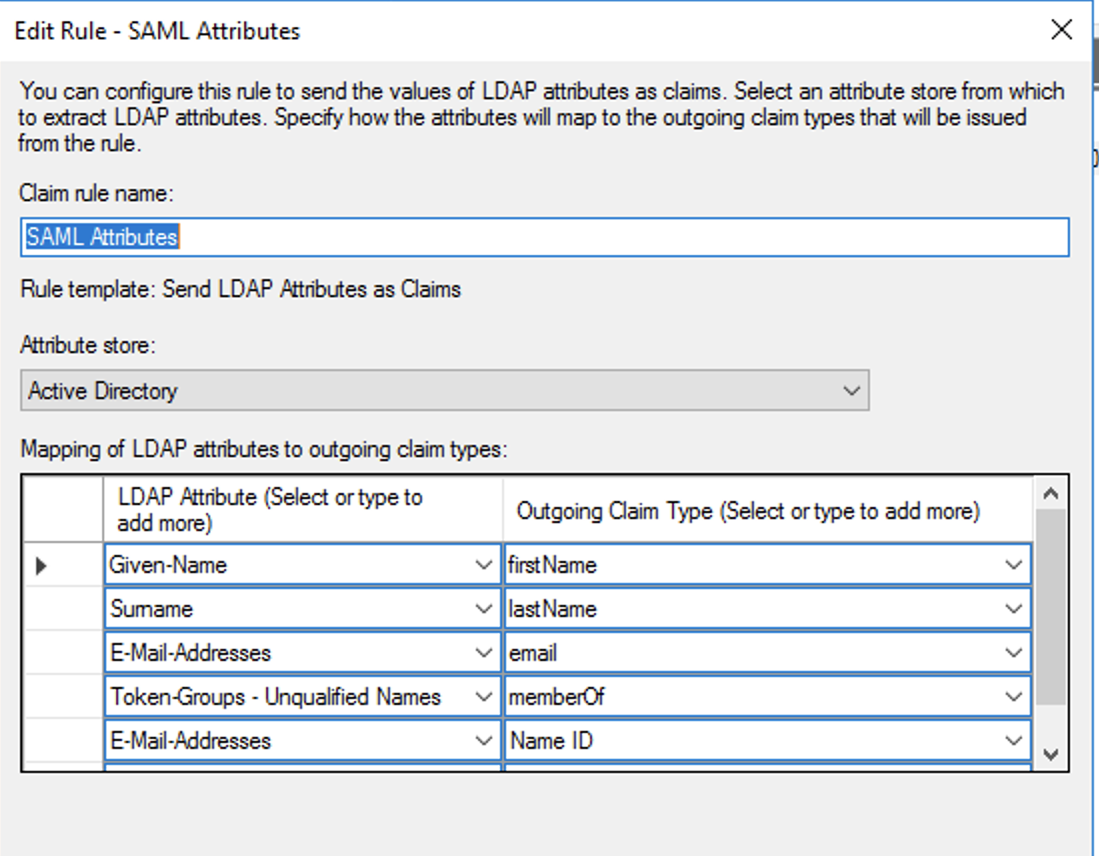SSO with ADFS
With Cyral, you can authenticate database users against your Active Directory Federation Service (ADFS) identity provider running in Windows Server 2016. Optionally, Cyral can read each user's group memberships from ADFS to determine the user's privileges.
Follow these steps to use your ADFS instance to authenticate database users and Cyral administrators. During this set up, you will configure a Relying Party Trust that connects ADFS and Cyral.
info
If you're using Azure AD, see the section, SSO with Azure AD.
Prerequisites
Make sure the following prerequisites are in place:
- You're running Windows Server 2016 Datacenter edition
- ADFS is activated
- SSL is configured. Cyral does not recommend using a self-signed certificate. If a self-signed certificate is to be used, it must be correctly configured (see for example, these steps.)
- Forms authentication is active for the ADFS server that will receive calls from Cyral. (You have the option to customize it as described here.)
Get ADFS properties
- In the Active Directory Server Manager, go to AD FS Management.
- Click on AD FS and choose Edit Federation Service Properties.
- Note the values for
- Federation Service display name
- Federation Service name
- Federation Service identifier
You will need these values later.
Add a relying party trust in ADFS
In the Active Directory Server Manager, go to AD FS Management.
Create a connection for Cyral by adding a relying party trust. Click AD FS: Relying Party Trusts: Add Relying Party Trust

Select Claims aware and click Start.
Choose Enter data about relying party manually and click Next.
Give this trust a Display name and click Next.
In Configure certificate, leave the certificate blank. Since communication will already be conducted over SSL and signed by a certificate, no additional layer of encryption is needed.
Enable SAML 2.0 WebSSO support. For the Relying party SAML 2.0 SSO service URL. We call this the endpoint; it's the SAML 2.0 endpoint provided by the Cyral control plane. Use an address in this format:
https://<your Cyral CP domain>.cyral.com:8000/auth/realms/default/broker/adfs-2016.<your federation service name>/endpointWhere your Cyral CP domain is the subdomain you use to reach the Cyral control plane, and your federation service name is the name you copied from the Federation Service Properties window in the previous section.
For example,
https://example.cyral.com:8000/auth/realms/default/broker/adfs-2016.example.com/endpointClick Next.
Enter a Relying party trust identifier that points to the Cyral control plane. This has the following format:
https://<your Cyral CP domain>.cyral.com:8000/auth/realms/defaultFor example,
https://example.cyral.com:8000/auth/realms/defaultIn the Access Control Policy, choose Permit everyone and proceed through the wizard without further edits.
Set up claims
You must create two claims as shown below. Values shown are case-sensitive.
Still working in the Active Directory Server Manager's AD FS Management section, navigate to AD FS: Relying Party Trusts.
Find the Cyral relying party trust entry that you created in the preceding section. Right click its name and choose Edit Claim Issuance Policy.

Add or edit the Inbound Claim rule, choosing the values as shown below.

Set the following:- Claim rule name: Inbound
- Incoming claim type: UPN
- Outgoing claim type: Name ID
- Outgoing name ID format: Transient Identifier
- Choose Pass through all claim values
Click OK.
Add or edit the Outbound Claim rule, choosing the values as shown below.

Set the following:- Claim rule name: Outbound
- Attribute store: Active Directory
- User-Principal-Name: UPN
- E-Mail-Addresses: Email
- Given-Name: FirstName
- Surname: LastName
- Token-Groups - Unqualified Names: Groups
Click OK.
Get SAML metadata
Now that you've saved your SAML configuration in ADFS, you can retrieve the SAML metadata file from your ADFS instance.
In your browser, navigate to the SAML metadata file address on your ADFS instance. This address uses the same base URL as the Federation Service name you noted in your Federation Service Properties earlier. It has the format:
https://<your federation service name>/FederationMetadata/2007-06/FederationMetadata.xmlFor example:
https://example.com/FederationMetadata/2007-06/FederationMetadata.xmltip
If this document is not available, it's likely that setup hasn't been completed correctly, or that the ADFS server isn't reachable, and debugging should be performed.
The SAML metadata file is a single-line XML document. Here's a partial example:
<EntityDescriptor ID="_t55a1ea-c11b-4091-9555-562026ed5d75" entityID="http://EC2AMAZ-5554MQA.ad.example.com/adfs/services/trust" xmlns="urn:oasis:names:tc:SAML:2.0:metadata">...Download this document to your desktop.
Your configuration in ADFS is nearly complete. You'll return to ADFS later to add the Cyral SAML certificate.
Add your ADFS as an IdP in Cyral
In this section, you'll register your ADFS instance as an SSO identity provider (IdP) in Cyral so your users can choose it and authenticate against it.
Open the Cyral control plane UI in your browser, click Integrations, find the Microsoft Active Directory Federation Services tile, click Configure and click New Integration.
Provide a Display Name for this SSO provider. This is the name your users and administrators will see when they use or set up this SSO provider.
caution
Once you've set this name, you cannot change it without deleting and recreating this SSO configuration.
Choose your ADFS version in the dropdown. Currently, Cyral supports Windows Server 2016 Datacenter.
In the Upload the SAML metadata document section, click Upload a file and choose the SAML metadata file you saved to your desktop in the preceding section.
Click Save.
Click the download icon to download the Cyral SAML certificate, and save it to your desktop.

In the next section, you'll add this certificate to your ADFS instance. This connection won't work until you've added the certificate in ADFS.
Add Cyral SAML certificate to ADFS
In this section, you'll add the Cyral SAML certificate as the signature certificate for your Cyral relying party in ADFS.
- In the Active Directory Server Manager's AD FS Management section, navigate to AD FS: Relying Party Trusts.
- Find the Cyral relying party trust entry and right click its name and choose
Properties.

- In the Properties window, click the Signature tab, click
Add, and upload the Cyral SAML certificate you saved in the
preceding section.

- Click Apply.
Your setup is complete. Your ADFS instance is now configured as an SSO provider in Cyral.
Next step
See Set up SSO authentication for users for the steps to activate SSO authentication on each repository that will use it.